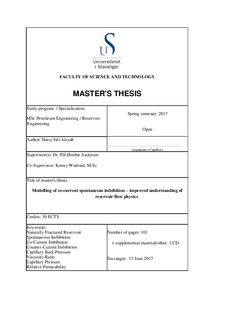| dc.contributor.advisor | Andersen, Dr. Pål Østebø | |
| dc.contributor.advisor | Walrond M.Sc, Kenny | |
| dc.contributor.author | Aisyah, Daisy Siti | |
| dc.date.accessioned | 2017-10-16T11:16:01Z | |
| dc.date.available | 2017-10-16T11:16:01Z | |
| dc.date.issued | 2017-06-16 | |
| dc.identifier.uri | http://hdl.handle.net/11250/2460279 | |
| dc.description | Master's thesis in Petroleum engineering | nb_NO |
| dc.description.abstract | Study of recovery mechanism in naturally fractured reservoir (NFRs), such as spontaneous imbibition has high interest in the oil industry to enhance oil production. Many studies of spontaneous imbibition such as counter-current and co-current imbibition have been carried out by researchers to understand more about the physical process of oil displacement from the matrix to the fracture. Understanding parameters influencing the spontaneous imbibition is a fundamental stage to obtain optimum oil recovery in NFRs.
To develop that understanding, the generated model from the successful spontaneous imbibition experiment is required. Experimental setup D has been chosen from spontaneous imbibition experiment with arbitrary fluid viscosity that was conducted by Haugland, H.K (2016). This type of experimental setup represent two ends open free spontaneous imbibition (TOEFSI) boundary condition where the inlet of imbibition tube is contact in with water, while the other side is oil-saturated outlet. As the result of five experiments from this setup, oil production mostly occurred by co-current flow for all experiments, while poor counter-current oil production was determined in one of these experiments.
Assuming horizontal homogeneous 1D model is generated from that setup D with applying TEOFSI boundary condition and allowing both co-current and counter-current imbibition to happen in this model. Corey-type Relative permeability and J-function capillary pressure correlation is used for developing the flow. Assuming atmospheric condition for the model which correspond to the condition of the experiment. Various of the imbibition tube length, viscosity ratio, relative permeability, the shape of capillary pressure curve, and the capillary back pressure are applied during simulation to investigate the change of controller parameters effect on the oil recovery and, analysis and understand the behaviour behind it.
As the result, high co-current or total (co + counter current) oil recovery is obtained when oil mobility is increased (i.e. high viscosity ratio (µw/µo)) with a reduction of tube length. These results are satisfied with the Haugland, H.K’s (2016) experimental result for viscosity ratio effect and another conducted experiment by Zhang, et al. (1996) for the increase of the core length effect. High imbibition rate that is induced from those parameters leads to oil to produce co-currently and vice versa.
The capillary pressure shape that affects the co-current production has been discovered during this parameter study. The combination of concave up and down-negative slope of capillary pressure curve can increase oil production co-currently. It might be due to high level of capillary back pressure shown in that shape restricts high oil pressure to overcome it. The various capillary back pressure is investigated by changing boundary water pressure. From the simulation result, counter-current production occurs when the boundary water pressure (Pcbw) is lower than the oil pressure inside the model. The reason is high oil pressure overcomes this type of pressure. On the other hand, the counter-current decreases as the Pcbw is higher than the oil pressure. Both counter-current and co-current production occurs if those pressure are equal. | nb_NO |
| dc.language.iso | eng | nb_NO |
| dc.publisher | University of Stavanger, Norway | nb_NO |
| dc.relation.ispartofseries | Masteroppgave/UIS-TN-IPT/2017; | |
| dc.rights | Navngivelse 4.0 Internasjonal | * |
| dc.rights.uri | http://creativecommons.org/licenses/by/4.0/deed.no | * |
| dc.subject | reservoir technology | nb_NO |
| dc.subject | petroleum technology | nb_NO |
| dc.subject | petroleumsteknologi | nb_NO |
| dc.title | Modelling of Co-Current Spontaneous Imbibition – Improved Understanding of Reservoir Flow Physics | nb_NO |
| dc.type | Master thesis | nb_NO |
| dc.subject.nsi | VDP::Technology: 500::Rock and petroleum disciplines: 510::Petroleum engineering: 512 | nb_NO |

